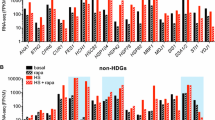Abstract
My laboratory has investigated the function of heat-shock proteins in Saccharomyces cerevisiae by cloning the genes encoding these proteins, creating mutations in the cloned genes by in vitro disruption mutagenesis, and replacingwild-typegeneswith the mutated versions by gene conversion in vivo (Rothstein, 1983). Here I will briefly review the results obtained with three genes, those encoding HSP26, HSP82, and HSP 104 (Fig. 1).
Access this chapter
Tax calculation will be finalised at checkout
Purchases are for personal use only
Preview
Unable to display preview. Download preview PDF.
Similar content being viewed by others
References
Borkovich, KA, Farrelly, FW, Finkelstein, DB, Taulien, J and Lindquist, S, (1989) hsp82 is an essential protein that is required in higher concentrations for growth of cells at higher temperatures. Mol. Cell Biol., 9: 3919–3930.
Brugge, J, Yonemoto, W ana Darrow, D, (1983) Interaction between the Rous sarcoma virus transferring protein and two cellular phosphoproteins: Analysis of the time-over and distribution of this complex. Mol. Cell. Biol., 3: 9–19.
Courtneidge, SA and Bishop, JM, (1982) Transit of pp60v-src to the plasma membrane. Proc. Natl. Acad. Sci. USA, 79: 7117–7121.
Catelli, MG, Binart, N, Jung-Testas, I, Renoir, J-M, Baulieu, E-E, etal., (1985) Hie common 90Kd protein component of non-transformed ‘85’ steroid receptors is a heat shock protein. EMBO J., 4: 3131–3135.
Ingolia, TD and Craig, EA, (1982) Four small Drosophila heat shock proteins are related to each other and to mammalian a-eristallin. Proc. Natl. Acad. Sci. USA, 79: 2360–2364.
Lindquist, S, (1986) The heat-shock response. Ann. Rev. Biochem., 55: 1151–1191.
Lindquist, S and Craig, EA, (1988) Hie heat shock proteins. Annu. Rev. Genet., 22: 631–677.
Petko, L and Lindquist, S, (1986) Hsp26 is not required for growth at high temperatures, northe thennotolerance, spore development, or germination. Cell, 45: 885–894.
Picard, D, Khursheed, B, Garabedian, MJ, Fortin, MG, Lindquist, S and Yamamoto, KR, (1990) Reduced levels of hsp90 compromise steroid receptor action in vivo. Nature, 348: 166–168.
Rossi, JM and Lindquist, SL, (1989) The intracellular location of yeast HSP26 varies with metabolism. J. Cell Biol., 108: 425–439.
Rothstein, RJ, (1983) One-step gene disruption in yeast. Methods Enzymol., 101: 201–211.
Sanchez, ER, Toft, DO, Schlessinger, MJ and Pratt, WB, (1985) Evidence that the 90-kda phosphoprotein associated with the untrasformed c-eell glucocorticoid is a murine heat shock protein. c., 260: 12398–12401.
Sanchez, Y and Lindquist, S, (1990) HSP104 required for induced thermotolerance. Science, 248: 1112–1115.
Susek, RE and Lindquist, SL, (1980) hsp26 of Saccharomyces cerevisiae is related to the superfamily of small heat shock proteins but is without a demonstrable function. Mol. Cell Biol., 9: 5265–5271.
Wejksnora, PJ and Haber, JE, (1978) Ribonueleoprotein particle appearing during sporulation in yeast. J. Baeteriol., 134: 246–260.
Author information
Authors and Affiliations
Editor information
Editors and Affiliations
Rights and permissions
Copyright information
© 1991 Springer-Verlag Berlin Heidelberg
About this paper
Cite this paper
Lindquist, S. (1991). Genetic Analysis of Heat Shock Protein Functions in Yeast. In: Maresca, B., Lindquist, S. (eds) Heat Shock. Springer, Berlin, Heidelberg. https://doi.org/10.1007/978-3-642-76679-4_14
Download citation
DOI: https://doi.org/10.1007/978-3-642-76679-4_14
Publisher Name: Springer, Berlin, Heidelberg
Print ISBN: 978-3-642-76681-7
Online ISBN: 978-3-642-76679-4
eBook Packages: Springer Book Archive




